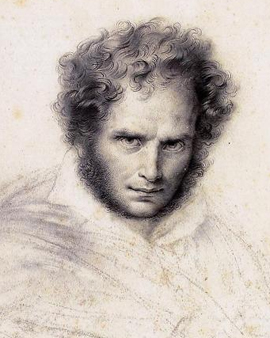The history painter and portraitist's full name was Anne-Louis Girodet de Roussy-Trioson and he was born in the small French town of Montargis in 1767. At the age of seven he was sent to Paris to be taught languages and natural sciences. It soon became clear, however, that his talents were of an artistic nature and that he was interested in drawing, sculpture and literature. From 1784 he received lessons from the history painter Jacques-Louis David. Five years later he was awarded first place for his painting "Joseph, Recognized by His Brothers" at an exhibition in Paris. The prize included a scholarship to study at the Académie de France in Rome. Afterwards he stayed in Rome for a total of five years.
Through his encounters in Italy and his artistic maturation, he began to develop his own style of painting, which stood out from that of his teacher David. Representative of his personal style is the magnificent work "The Flood" (1806). It is full of dramaturgy, creativity and mysticism. At the Paris Salon in 1810, the painting achieved better marks and attracted more attention than "The Robbery of the Sabine Women" (1799) by his former teacher David. Girodet-Trioson was a member of several academies and associations, worked a lot at night and led a dissolute life. After his fortieth year, his life forces slowly began to dwindle. From his late creative years, particularly beautiful and impressive portraits are known, for example "Madame Jacques-Louis-Étienne Reizet" (1823). His works were characterized by precision, rich colour, a variety of light effects and harmony. In 1824 the gifted artist retired from life in Paris. Some of his drawings subsequently fetched high prices at auctions.
×





_Refusing_the_Gifts_of_Artaxerxes_I_(d425_BC)_1792_-_(MeisterDrucke-114748).jpg)
_Refusing_the_Gifts_of_Artaxerxes_I_(d425_BC)_1792_-_(MeisterDrucke-114748).jpg)
_-_(MeisterDrucke-88808).jpg)
_-_(MeisterDrucke-88808).jpg)
.jpg)
.jpg)
 1824 - (MeisterDrucke-64430).jpg)
 1824 - (MeisterDrucke-64430).jpg)
.jpg)
.jpg)
.jpg)
.jpg)
_generalissime_Vendeen_-_(MeisterDrucke-901738).jpg)
_generalissime_Vendeen_-_(MeisterDrucke-901738).jpg)
 - (MeisterDrucke-301472).jpg)
 - (MeisterDrucke-301472).jpg)
 - (MeisterDrucke-103942).jpg)
 - (MeisterDrucke-103942).jpg)
.jpg)
.jpg)
_-_(MeisterDrucke-911822).jpg)
_-_(MeisterDrucke-911822).jpg)
.jpg)
.jpg)
 engraved by Raphael Urbain Massard (1775-1843) 1824 - (MeisterDrucke-61547).jpg)
 engraved by Raphael Urbain Massard (1775-1843) 1824 - (MeisterDrucke-61547).jpg)
 Receiving the Keys of Vienna at the Schloss Schonbrunn 13th November 1805 1808 - (MeisterDrucke-115748).jpg)
 Receiving the Keys of Vienna at the Schloss Schonbrunn 13th November 1805 1808 - (MeisterDrucke-115748).jpg)
.jpg)
.jpg)
_-_(MeisterDrucke-50958).jpg)
_-_(MeisterDrucke-50958).jpg)
.jpg)
.jpg)
.jpg)
.jpg)
 - (MeisterDrucke-58738).jpg)
 - (MeisterDrucke-58738).jpg)
_-_(MeisterDrucke-52861).jpg)
_-_(MeisterDrucke-52861).jpg)
.jpg)
.jpg)
 engraved by Raphael Urbain Massard (1775-1843) 1824 - (MeisterDrucke-60200).jpg)
 engraved by Raphael Urbain Massard (1775-1843) 1824 - (MeisterDrucke-60200).jpg)
.jpg)
.jpg)
.jpg)
.jpg)
 - (MeisterDrucke-94298).jpg)
 - (MeisterDrucke-94298).jpg)
.jpg)
.jpg)
.jpg)
.jpg)
.jpg)
.jpg)
.jpg)
.jpg)
.jpg)
.jpg)
.jpg)
.jpg)
.jpg)
.jpg)
.jpg)
.jpg)
.jpg)
.jpg)
.jpg)
.jpg)
 formerly attributed to Jacques Louis David (1748-1825) 1808 - (MeisterDrucke-64847).jpg)
 formerly attributed to Jacques Louis David (1748-1825) 1808 - (MeisterDrucke-64847).jpg)
.jpg)
.jpg)
.jpg)
.jpg)
.jpg)
.jpg)
_The_emperor_returne_-_(MeisterDrucke-961500).jpg)
_The_emperor_returne_-_(MeisterDrucke-961500).jpg)
 1795 - (MeisterDrucke-70647).jpg)
 1795 - (MeisterDrucke-70647).jpg)
.jpg)
.jpg)
.jpg)
.jpg)
.jpg)
.jpg)
.jpg)
.jpg)
.jpg)
.jpg)
_-_(MeisterDrucke-45323).jpg)
_-_(MeisterDrucke-45323).jpg)
.jpg)
.jpg)
.jpg)
.jpg)
 engraved by Mathieu (19th century) - (MeisterDrucke-39662).jpg)
 engraved by Mathieu (19th century) - (MeisterDrucke-39662).jpg)
.jpg)
.jpg)
.jpg)
.jpg)
 1805 - (MeisterDrucke-73334).jpg)
 1805 - (MeisterDrucke-73334).jpg)
.jpg)
.jpg)
.jpg)
.jpg)
.jpg)
.jpg)
.jpg)
.jpg)
 1824 - (MeisterDrucke-113891).jpg)
 1824 - (MeisterDrucke-113891).jpg)
.jpg)
.jpg)
 1800 - (MeisterDrucke-142133).jpg)
 1800 - (MeisterDrucke-142133).jpg)
.jpg)
.jpg)
.jpg)
.jpg)
.jpg)
.jpg)
.jpg)
.jpg)
.jpg)
.jpg)
.jpg)
.jpg)
.jpg)
.jpg)
.jpg)
.jpg)
.jpg)
.jpg)
.jpg)
.jpg)
.jpg)
.jpg)
 - (MeisterDrucke-50926).jpg)
 - (MeisterDrucke-50926).jpg)
.jpg)
.jpg)
.jpg)
.jpg)
 - (MeisterDrucke-82979).jpg)
 - (MeisterDrucke-82979).jpg)
.jpg)
.jpg)
 - (MeisterDrucke-84155).jpg)
 - (MeisterDrucke-84155).jpg)
.jpg)
.jpg)
.jpg)
.jpg)
.jpg)
.jpg)
.jpg)
.jpg)
_Italian_revolutionary_Painting_by_Anne_-_(MeisterDrucke-951182).jpg)
_Italian_revolutionary_Painting_by_Anne_-_(MeisterDrucke-951182).jpg)
.jpg)
.jpg)
_meditating_on_th_-_(MeisterDrucke-908053).jpg)
_meditating_on_th_-_(MeisterDrucke-908053).jpg)
 - (MeisterDrucke-115860).jpg)
 - (MeisterDrucke-115860).jpg)
.jpg)
.jpg)
.jpg)
.jpg)
 Vicomte de Chateaubriand 1811 (see also 245771) - (MeisterDrucke-58719).jpg)
 Vicomte de Chateaubriand 1811 (see also 245771) - (MeisterDrucke-58719).jpg)
.jpg)
.jpg)
.jpg)
.jpg)
_Vicomte_de_Chateaubriand_c1811_(see_also_-_(MeisterDrucke-37595).jpg)
_Vicomte_de_Chateaubriand_c1811_(see_also_-_(MeisterDrucke-37595).jpg)
.jpg)
.jpg)
.jpg)
.jpg)
 1804 - (MeisterDrucke-112745).jpg)
 1804 - (MeisterDrucke-112745).jpg)
.jpg)
.jpg)
.jpg)
.jpg)
.jpg)
.jpg)
.jpg)
.jpg)
.jpg)
.jpg)
.jpg)
.jpg)






